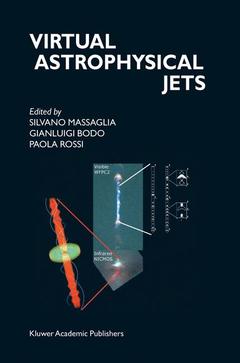Description
Virtual Astrophysical Jets, 2004
Theory Versus Observations
Coordinators: Massaglia Silvano, Bodo Gianluigi, Rossi P.
Language: English
Subjects for Virtual Astrophysical Jets:
Keywords
Accretion; Galaxy; astrophysics; relativistic jet; star; stellar
Virtual astrophysical jets
Publication date: 03-2012
269 p. · 15.5x23.5 cm · Paperback
Publication date: 03-2012
269 p. · 15.5x23.5 cm · Paperback
Virtual astrophysical jets
Publication date: 12-2004
269 p. · 16x24 cm · Hardback
Publication date: 12-2004
269 p. · 16x24 cm · Hardback
Description
/li>Contents
/li>Comment
/li>
These proceedings are the result of a three-day meeting held in Oogliani (Italy), on October 2-4 2003, whose title was "VIrtual Astrophysical Jets 2003". Our goal in convening this meeting was to gather some of the scientists among the most active in the field of numerical simulations and modelling of astrophysi cal jets. For keeping the participants close to the "real world", we also invited a few observers to give up-to-date reviews outlining the state-of-the-art of jet observations. The principal aim of the meeting was thus to present and critically discuss the state-of-the-art numerical simulations, analytical models and laboratory ex periments for reproducing the main aspects of astrophysical jets and compar ing them with observations. The discussion has been focused on the following topics: ? Observations and intepretions of jets from young stars and AGNs, comparisons of models with observations; ? MHO accelerations of jets: steady self-similar models, MHO numerical simula tions of time-dependent accelerations mechanisms; ? Jet stability and interaction with the ambient: formation of knots in YSO jets, jet survival to instabilities, deceleration of relativistic jets in FRI sources, simulations of jets-IGM interactions, jets propagation and galaxy formation; ? Numerical codes and their validation: relativistic MHO codes, comparisons among different numerical schemes, jets in the laboratory and code validation. These topics have been discussed intensively during the meeting, and the out come of these discussions is presented in this volume. The contributions have been divided in five sections.
Observational Properties of Jets in Active Galactic Nuclei.- AGN Jet Modeling: Setting the Stage.- Interpreting the Observations of Herbig-Haro Jets.- Virtual Versus Real Jets: New Clues from the Hubble Space Telescope.- The Origin of Jets from Young Stars: Steady State Disk Wind Models Confronted to Observations.- Steady and Time-Dependent MHD Modelling of Jets.- The Efficiency of the Magnetic Acceleration in Relativistic Jets.- MHD Outflows from Hot Coronae.- Virtual Jets: From Self-Similar to Numerical Solutions.- MHD Accretion-Ejection Flows.- On the MHD Acceleration of Astrophysical Jets.- MHD Simulations of Crab’s Jet and Torus.- The Stability Properties of Astrophysical Jets.- How Can Jets Survive MHD Instabilities?.- Stability of Relativistic Hydrodynamical Planar Jets: Linear and Nonlinear Evolution of Kelvin-Helmholtz Modes.- Entrainment and Deceleration of Relativistic Jets.- MHD Simulations of Relativistic Jets.- Computation of X-Ray Blazar Light Curves using RHD Simulations.- Effects of the Magnetic Field on the H? Emission from Jets.- Properties of Knots in Cooling Stellar Jets.- Are Astrophysical Shear Flows Able to Heat Themselves?.- Astrophysical Jet Simulations: Comparing Different Numerical Methods.- Axisymmetric Simulations of Pulsar Wind Nebulae with a New Central-Type Scheme for Relativistic MHD.- Simulating Magnetized Jets.- Experiments and Numerical Simulations on the Mid-Term Evolution of Hypersonic Jets.- Jet Propagation Through Irregular Media and the Impact of Lobes on Galaxy Formation.- Numerical Simulations of the Interaction of Jets with the Intracluster Medium.- Large Scale Simulations of the Jet-IGM Interaction.- The Environment of YSO Jets.
Provides a global view on stellar jets and extragalactic jets unlike other books which deal with only one of these The authors are among the most active scientists in the field of theoretical interpretation of the astrophysical jets phenomenology and therefore this book can be considered as the most up-to-date in this field Astrophysical jets are collimated outflows of matter and fields that originate typically, but not uniquely, from Active Galactic Nuclei (AGNs) and young stars (YSOs). Jets from AGNs have linear sizes ranging from few up to thousand light years and velocities close to the speed of light, whereas jets from YSOs may reach few parsecs in size and some hundreds kilometers per second in speed. The study of astrophysical jets is utterly important since intimately connected with the formation and evolution of galaxies and stars and the dynamical processes of the interstellar and intergalactic medium
© 2024 LAVOISIER S.A.S.




